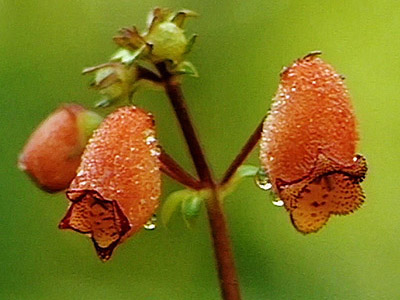 |
A great transformation is underway
on planet Earth.
From the most remote mountaintops to forests, grasslands, and deserts, from river headwaters to the deepest seas, reports from around the globe tell the same story: wild places that have been stable for millions of years are in turmoil. Weather patterns and water sources are being disrupted. Plant and animal species are vanishing faster than ever before. Our cities and farms, our parks, even our backyards are changing in ways we're only beginning to notice, but that are already affecting the health and well-being of our planet, and us.
During the four billion years that life has been evolving on Earth there have been five distinct periods when as much as 90% of the species alive at the time suddenly disappear from the fossil record. The most recent of these events ended the reign of the dinosaurs 65 million years ago. Paleontologists believe that each of these earlier mass extinctions was triggered by some extraordinary event such as an asteroid impact or a period of unusual volcanic activity. Each of these extinction spasms was actually a slow decline, taking place over many centuries, yet these periods were brief compared to the many millions of years the Earth took to recover its diversity after each mass extinction had finally run its course. |
 |
Today, scientists believe that we are entering the 6th Mass Extinction. But unlike the previous five, this one will not take centuries to unfold—in fact, it will take place in our lifetimes. As scientists begin to realize the severity of the crisis and new worldwide assessments are made, the news is difficult to believe. At least half of all plant and animal species are likely to disappear in the wild within the next 30-40 years, including many of the most familiar and beloved large mammals: elephants, polar bears, chimpanzees, gorillas and all the great apes, all the big cats, and many, many others. Bird species are similarly imperiled, songbird populations have declined by 50% in the last 40 years. One out of every eight species of plant life worldwide and almost one third of the plant species within the United States already face extinction. Populations of large ocean fish have declined by 90% since the 1950s. All around the world, birds, reptiles, mammals, amphibians, fish, and invertebrates, as well as trees, flowering plants, and other flora, are all in steep decline. The rate of extinction today could be as much as 10,000 times greater than the expected natural or background extinction rate. Scientists estimate that tens of thousands of species are vanishing every year, including many that have yet to be discovered or named.
|
 |
We depend on many species directly for our basic human needs such as food, clothing, fuel, shelter, and medicine, but the complex network of all species is necessary to support those species that we depend upon directly. Ecosystems are intricately interdependent—species depend on each other for survival in complex and subtle ways that science is only beginning to understand. Biologically diverse ecosystems provide indispensable ecosystem services that we often take for granted, including purification of the air and water, climate regulation, nutrient cycling in the soil, disease control, pollination, seed dispersal, biological pest control, and prevention of erosion, to name just a few. We cannot live without these essential services that healthy ecosystems provide.
When any species within an ecosystem becomes extinct, species that depend on that species are threatened and other species that depend on those species will become threatened and so on, in a cascade or ripple effect that runs through the whole system. The loss of any species within the ecosystem can potentially affect the ability of other species to thrive, or even survive. What’s more, a species does not need to become totally extinct in order to have this effect. A severe decline in a species' population can be nearly as detrimental to the ecosystem as extinction and can weaken the entire ecosystem. As stresses due to species loss increase, eventually the ecosystem will reach a breaking point, after which total catastrophic collapse is rapid and irreversible. |
Researchers have identified six primary direct drivers of extinction and all are the result of human behavior: habitat loss, invasive species, pollution, climate change, over-exploitation of resources, and above all—the factor that magnifies all the others—human overpopulation. Any of these drivers can wreak havoc by itself, but in combination with each other and with other social and environmental factors, their cumulative effects are devastating. The mass extinction will not be slowed or averted until each of these direct drivers is controlled or eliminated.
|
Call of Life examines the collective and individual responses that will be needed to mitigate the impacts of the mass extinction and makes clear the critical choices we have before us. We face the potential of the natural world devastated beyond recognition, with the loss of human life in the billions. Yet, we still have time to avert the worst of the crisis and save much of the biosphere, if we act now. The first step to is to create broad public awareness of the problem—its magnitude and its implications. Only then can our whole society begin to recognize the systemic changes that will be required. The solution is clear: in order to save our planet and secure a future for our own species and all species, we need a new worldview. We must recognize that technology alone cannot save us. We must realize that business-as-usual is no longer an option. Instead, we need to create fundamental change in our culture, our minds, and our hearts. Unique among all human generations, those of us alive today have been given a great opportunity: one last chance to preserve the vitality and magnificence of the living planet that brought us into being, and is our only home. |
 |
|
|
|
|







